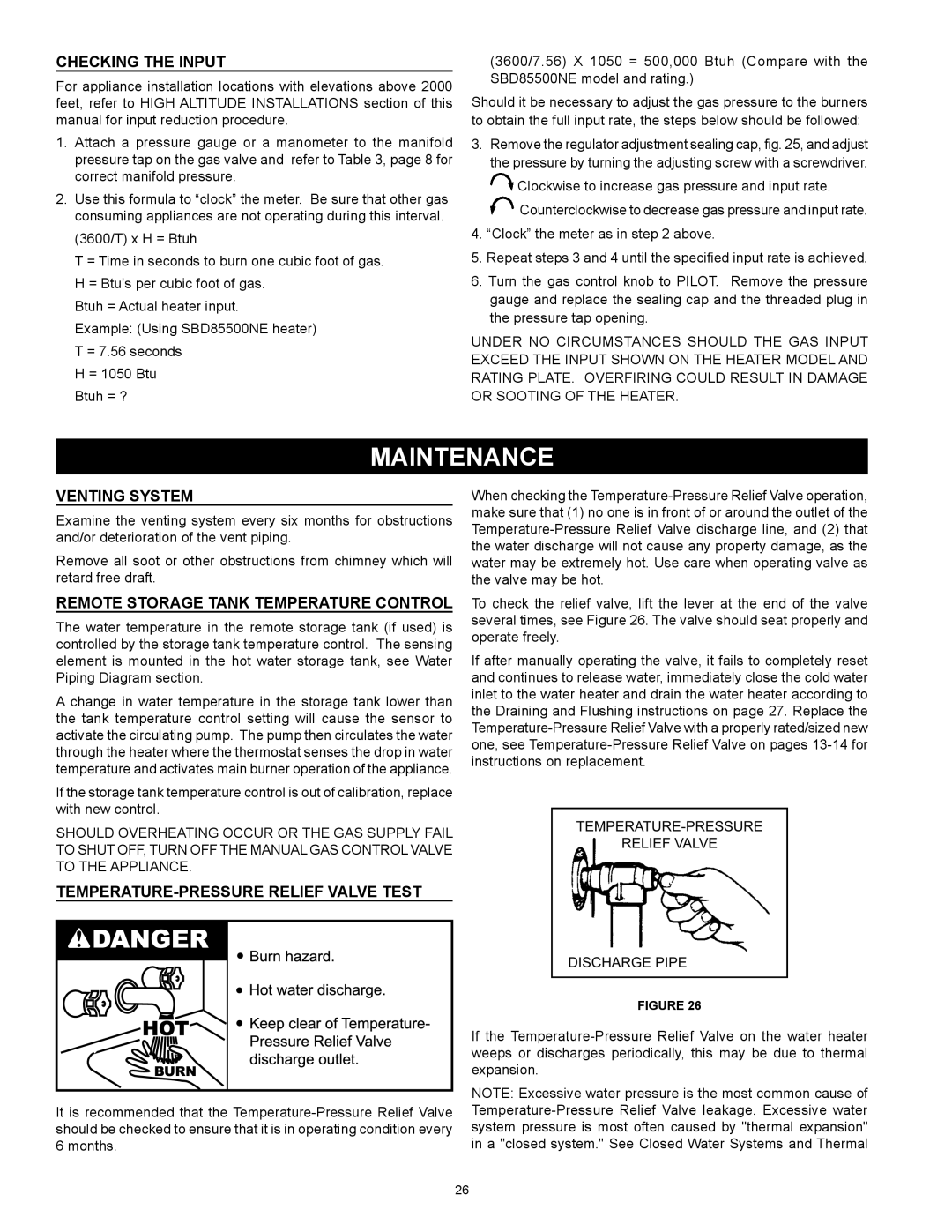
Checking the Input
For appliance installation locations with elevations above 2000 feet, refer to HIGH ALTITUDE INSTALLATIONS section of this manual for input reduction procedure.
1.Attach a pressure gauge or a manometer to the manifold pressure tap on the gas valve and refer to Table 3, page 8 for correct manifold pressure.
2.Use this formula to “clock” the meter. Be sure that other gas consuming appliances are not operating during this interval. (3600/T) x H = Btuh
T = Time in seconds to burn one cubic foot of gas. H = Btu’s per cubic foot of gas.
Btuh = Actual heater input.
Example: (Using SBD85500NE heater) T = 7.56 seconds
H = 1050 Btu Btuh = ?
(3600/7.56) X 1050 = 500,000 Btuh (Compare with the SBD85500NE model and rating.)
Should it be necessary to adjust the gas pressure to the burners to obtain the full input rate, the steps below should be followed:
3.Remove the regulator adjustment sealing cap, fig. 25, and adjust the pressure by turning the adjusting screw with a screwdriver.
![]() Clockwise to increase gas pressure and input rate.
Clockwise to increase gas pressure and input rate. ![]() Counterclockwise to decrease gas pressure and input rate.
Counterclockwise to decrease gas pressure and input rate.
4.“Clock” the meter as in step 2 above.
5.Repeat steps 3 and 4 until the specified input rate is achieved.
6.Turn the gas control knob to PILOT. Remove the pressure gauge and replace the sealing cap and the threaded plug in the pressure tap opening.
UNDER NO CIRCUMSTANCES SHOULD THE GAS INPUT EXCEED THE INPUT SHOWN ON THE HEATER MODEL AND
RATING PLATE. OVERFIRING COULD RESULT IN DAMAGE OR SOOTING OF THE HEATER.
mAINTENANCE
Venting System
Examine the venting system every six months for obstructions and/or deterioration of the vent piping.
Remove all soot or other obstructions from chimney which will retard free draft.
Remote Storage Tank Temperature Control
The water temperature in the remote storage tank (if used) is controlled by the storage tank temperature control. The sensing element is mounted in the hot water storage tank, see Water Piping Diagram section.
A change in water temperature in the storage tank lower than the tank temperature control setting will cause the sensor to activate the circulating pump. The pump then circulates the water through the heater where the thermostat senses the drop in water temperature and activates main burner operation of the appliance.
If the storage tank temperature control is out of calibration, replace with new control.
SHOULD OVERHEATING OCCUR OR THE GAS SUPPLY FAIL TO SHUT OFF, TURN OFF THE MANUAL GAS CONTROL VALVE TO THE APPLIANCE.
Temperature-Pressure Relief Valve Test
When checking the
To check the relief valve, lift the lever at the end of the valve several times, see Figure 26. The valve should seat properly and operate freely.
If after manually operating the valve, it fails to completely reset and continues to release water, immediately close the cold water inlet to the water heater and drain the water heater according to the Draining and Flushing instructions on page 27. Replace the
It is recommended that the
FIGURE 26
If the
NOTE: Excessive water pressure is the most common cause of
26
